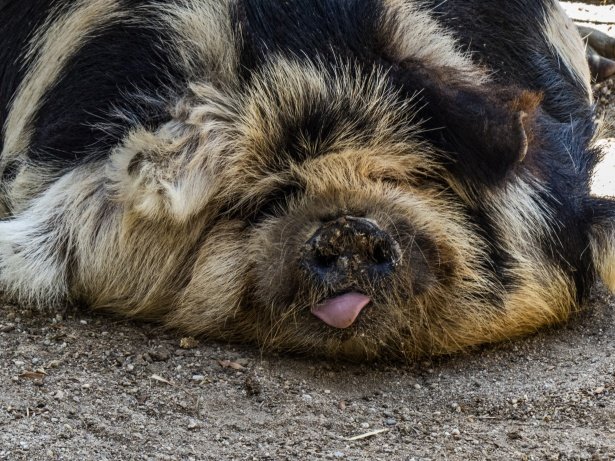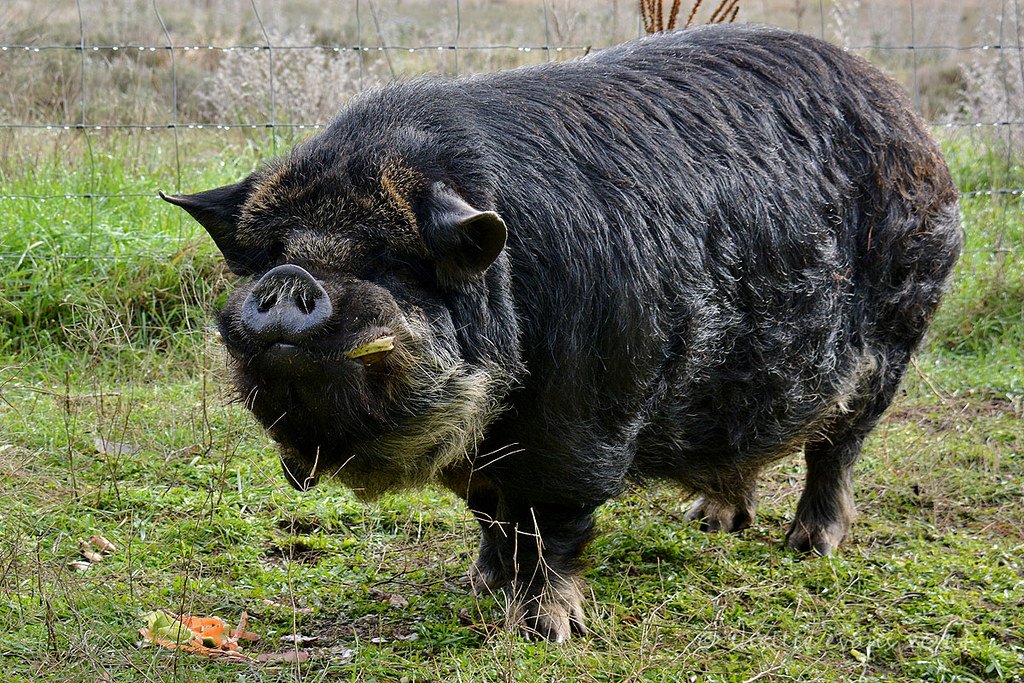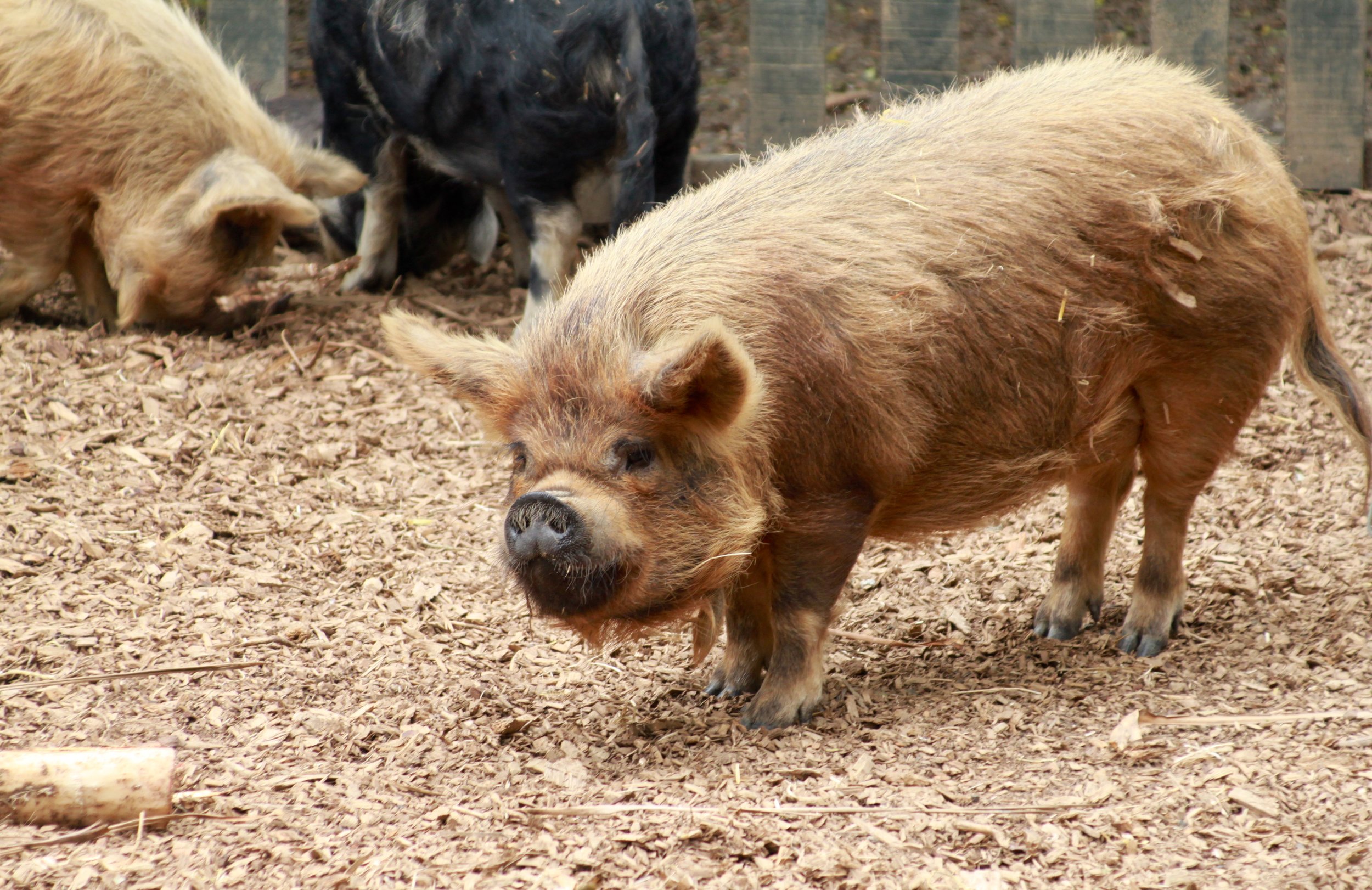What Are Kunekune Pigs?
Pigs are interesting animals to have on the farm and somewhat eccentric animals to have as a pet, considering their size. However, there are smaller breeds with excellent attitudes that make perfect pets provided you have the accommodations for them.
The Kunekune breed of pig is an amazing option for a pig to raise because of its docile nature and amazing intelligence. It is easy to train, is great with children, and is much less destructive than other pig breeds. While they can be sourced for meat, they make good pets.
In this article, we will discuss all the benefits of raising Kunekune pigs, both as livestock and as pets, and also any drawbacks that are associated with the breed. We’ll cover everything you need to know about raising them, including housing and feeding.
Read on for the ultimate guide to Kunekune pigs!
**J&R Pierce Family Farm is a participant in the Amazon Services LLC Associates Program, an affiliate advertising program designed to allow sites to earn advertising fees by linking to products on Amazon. I often link to Amazon when recommending certain products, and if you choose to purchase, I may earn a small percentage of the sale. It costs you nothing extra, and all recommended products are ones that I personally vouch for.**
What is So Special About Kunekune Pigs?
Kunekune pigs are not your average pig. They’re long-haired with a mysterious origin that no one truly knows. Here’s why they’re so special:
They come in a variety of colors
They were once endangered
They can be kept as pets
They can be sourced for meat
They have an excellent temperament, even with children
They are not destructive
The sows make excellent mothers, with little problems giving birth
Their meat is absolutely delectable
They are excellent sources of lard
For more information on keeping the Kunekune breed of pigs as pets, you can watch this video:
What Are Kunekune Pigs?
The Maori are a native people in New Zealand, and in their language, Kunekune, translates to fat and round - which is an apt description of these pigs. The Maori have kept the Kunekune for millennia to be able to use them as food during times of feasting.
However, their origins are up for debate. Many believe the Maori brought the first Kunekune to the New Zealand mainland in their canoes.
Other factors, such as the Piri Piri, or wattles, indicate that Asian expeditions were the source of their arrival. These wattles are also commonly found on Asian domestic pigs.
While not all Kunekune pigs have Piri Piri, they are considered a breed trait. What’s interesting is that two-wattled pigs can produce unwattled offspring and vice versa. Despite all of them not having wattles, it is a distinguishing mark of the breed.
The color and texture of their coats vary widely, giving them quite a variety in appearance. Some Kunekune even feature spots or patterns to go along with their coloring. In the summer, it’s not uncommon for these pigs to experience significant hair loss due to the heat.
During the 1970s, it was believed that the Kunekune breed was nearly extinct. A group of advocates collected nine purebred specimens to rehabilitate the species, which now numbers in the thousands in several countries.
Kunekune Pigs Size
Female Kunekune pigs generally have a size range of 100 to 175 pounds, while the males can grow to 200 to upwards of 250 pounds. They can reach a maximum of 450 pounds and are 30 inches long. So, while this breed is small, it’s still pretty hefty.
What Are Kunekune Pigs Used For?
Kunekune, unlike most pigs, are for more than just meat. They have such a sweet, docile temperament that they can make an excellent pet, provided you can accommodate them at their largest size.
Is a Kunekune Pig a Good Pet?
Kunekune pigs have docile temperaments, making them ideal pets for the first-time pig owner. Unlike many breeds of pig, they thrive on human interaction. They enjoy spending time with their humans, including children, playing and relaxing.
They’re also very smart and easy to train. Unfortunately, their high level of intelligence can lead to a destructive side when they don’t receive enough mental stimulation or attention.
In addition, there are some restrictions in certain places about what kind of animal can be a pet. Regardless of how you feel about your Kunekune, your local laws may consider it livestock, requiring special accommodations.
You’ll need to verify with your local ordinances whether you can have a Kunekune as a pet before you purchase one. You also need to ensure you have the space to accommodate a 200-pound pig should it grow to that size. If not, consider a different pet.
While many pet pig owners enjoy having their pigs in the house with them, a Kunekune will need easy access to the outdoors, where it can graze. They also prefer to move between the indoors and outdoors. You’ll have to consider this when setting up housing.
Can You Eat Kunekune Pigs?
The Maori of New Zealand were long known for keeping Kunekune for feast times. Today, they are commercially farmed for their meat.
This breed is much slower to mature than alternatives but produces flavorful, red-marbled meat. It’s surrounded by a layer of fat that locks in the succulent flavor that is unique to this breed.
Additionally, they are heavy producers of lard. So if you have a taste for it or cook with it a lot, this is the pig for your farming operation.
Housing Kunekune Pigs
Kunekune pigs are the easiest pigs to care for because they require so little maintenance. Simple fencing and housing are all that’s required to keep them happy. Their docile temperaments keep them from being destructive.
Can You Raise Kunekune Pigs on Pasture?
Kunekune pigs are big grazers and will consume most of their diet from the grasses in the pasture. While they are out there, they will need shelter from the elements. It can be something simple like a three-sided structure, like this A frame.
The structure must be large enough that all the pigs can fit inside and curl up together for warmth. They also need access to a mud hole to cool off in the summer. As they only sweat through their noses, this is essential to regulating their body temperatures.
Fencing for Kunekune Pigs
Fencing for Kunekune pigs can be the same as what you would use for sheep or goats. While many choose to use electric fencing, it’s something that would need to be taught to the pigs early on so that they know to respect it.
Are Kunekune Pigs Destructive?
Generally speaking, Kunekune pigs are less destructive than all other pig breeds. They do not root around when eating, leaving your fields looking pristine. They also do not challenge fences, as they are generally very docile.
However, because of their high level of intelligence, if they start to feel neglected by not receiving enough mental stimulation or attention from you, they may be destructive on purpose.
Kunekune Pigs in Winter
Depending on your location, you may need to house your Kunekune in a bar over the winter. Unless they have new piglets, they will not need extra heat, as they are very cold-hardy. They will all curl together for body heat, staying warm throughout the colder months.
If you do have new piglets to care for, you will need to add a heat lamp. Ensure that it is installed so that the barn does not catch fire. It should not physically be touching anything with the hot part of the lamp.
Feeding Kunekune Pigs
Kunekune pigs are very big grazers. Their snouts are tipped up slightly, allowing them to graze without rooting up everything in their path to get food. You may need to supplement their diets with grain, depending on the quality of the grasses available and the season.
They love grasses and will need to have free access to go inside and outside as they please to graze at will. This is the same whether they are pets or livestock. However, you may want to keep them from the pasture in the rainy season, as this will compact the grasses.
Breeding Kunekune Pigs
Boars are ready for breeding at eight months old but do not achieve complete fertility until 12 months. They receive their secondary characteristics around 18 months.
The sow’s heat period lasts 8 to 48 hours and will repeat every 18 to 22 days until she becomes pregnant. A pregnancy will last approximately 116 days, and roughly one week before delivery, the sow should be transferred to the farrowing pen.
Kunekune sows are often excellent mothers who have no problems giving birth to and raising their young. The average litter size is between six and eight piglets. Smaller litters of one and two are very rare, as the pig will usually abort or reabsorb the babies.
There can also be problems with infertility. It has been found that boars often have different levels of fertility that correspond to the time of the year. With extremes in heat and cold, their fertility levels can drop.
For sows, it’s a little bit different. Their infertility changes can be caused by hormonal imbalance, damage to the reproductive tract due to infection, and a body condition that’s too fat or too thin.
Hormonal therapy can be an option for a few months, but if it still doesn’t worry, you’ll need to consider culling her.
Do Kunekune Pigs Have Any Health Issues?
Kunekune can face problems with diarrhea. It can be caused by dietary changes or bacterial infections, such as E. coli and Rotaviruses. In young pigs, it can get so severe that it becomes a life-threatening situation.
There are several respiratory infections, including pneumonia, bronchitis, and nasal infections. Coughing may be a symptom but also may be caused by lungworm infection.
Leptospirosis, Toxoplasmosis, and Parvovirus can all cause a sow to give birth early or abort her litter. Any stillborn piglets must be handled with care to prevent the spread of Leptospirosis to humans.
Congenital abnormalities sometimes occur in which the piglets are not viable. These can include being born without an anus. Umbilical or scrotal hernias are conditions that indicate the pig should not be bred, as these are heritable conditions.
Kunekune pigs are also susceptible to mange and lice. Mange will leave them with crusty patches, poor growth rate, and ill thrift. Lice are large and brown, moving around when disturbed.
Pros and Cons of Kunekune Pigs
Some of the benefits of raising Kunekune pigs are as follows:
Smaller and easier to train
Excellent, mild-mannered disposition that most pigs do not have
Work well in confined spaces
Won’t constantly challenge fences and escape
Prefer to eat grass, saving money on feed
Excellent lard pigs
Don’t require much housing
Have minimal health needs
The challenges of raising Kunekune pigs like in their very slow maturation rates. It takes a lot longer to get meat from these pigs than it does from standard, larger breeds. However, this breed also produces a significant amount of lard per pig.
Where to Find Kunekune Pigs for Sale
Kunekune pigs are not as widespread and popular in the United States as they are in the United Kingdom and New Zealand. However, by searching for a breeder, you can find them for sale.
You will want to look for a reputable breeder with healthy stock that will let you see the stock before you purchase it.
Final Thoughts
Kunekune pigs are incredibly smart, fantastically friendly, and docile creatures. They are amazing with children, unlike many other pig breeds, and thrive on human interaction. Because of this, they make ideal pets in addition to being meat stock for your farm.
They don’t require a lot in the way of housing, accepting a simple three-sided structure in the pasture to protect them from the elements. The winter may require the use of a barn, depending on how cold it gets where you live, but they won’t need extra heat.
If you are raising Kunekune for meat, expect to wait longer than with other pig breeds to get your cut. Additionally, expect less meat from these little pigs as they are more prone to producing lard. However, the meat that you do receive will be succulent and absolutely to die for.
So what do you think? Are you going to add Kunekune pigs to the list? Let me know your experiences by chiming in within the comments section below!
Want to learn more about farming? Be sure to check out these featured articles!
Subscribe to our email newsletter for regular tips and tricks on homesteading and farming – wherever you are. You can also follow us on Instagram (@jrpiercefamilyfarm) and Pinterest (J&R Pierce Family Farm) for frequent updates. Happy homesteading!








